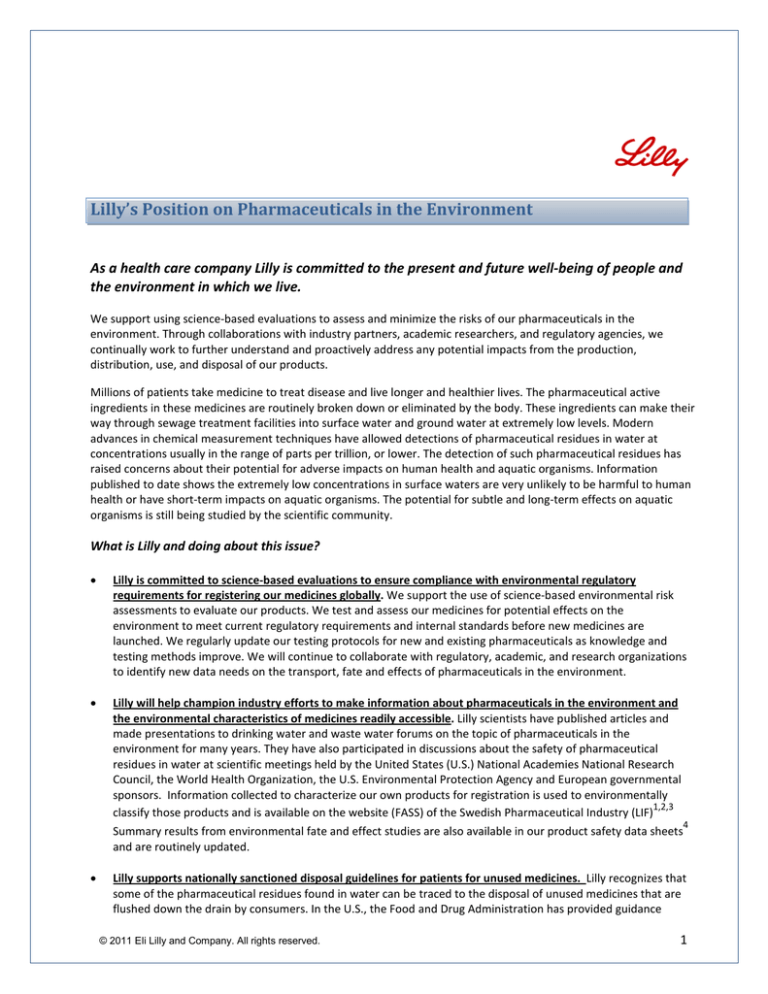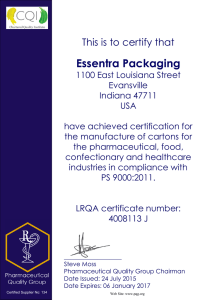
Lilly’s Position on Pharmaceuticals in the Environment
As a health care company Lilly is committed to the present and future well-being of people and
the environment in which we live.
We support using science-based evaluations to assess and minimize the risks of our pharmaceuticals in the
environment. Through collaborations with industry partners, academic researchers, and regulatory agencies, we
continually work to further understand and proactively address any potential impacts from the production,
distribution, use, and disposal of our products.
Millions of patients take medicine to treat disease and live longer and healthier lives. The pharmaceutical active
ingredients in these medicines are routinely broken down or eliminated by the body. These ingredients can make their
way through sewage treatment facilities into surface water and ground water at extremely low levels. Modern
advances in chemical measurement techniques have allowed detections of pharmaceutical residues in water at
concentrations usually in the range of parts per trillion, or lower. The detection of such pharmaceutical residues has
raised concerns about their potential for adverse impacts on human health and aquatic organisms. Information
published to date shows the extremely low concentrations in surface waters are very unlikely to be harmful to human
health or have short-term impacts on aquatic organisms. The potential for subtle and long-term effects on aquatic
organisms is still being studied by the scientific community.
What is Lilly and doing about this issue?
•
Lilly is committed to science-based evaluations to ensure compliance with environmental regulatory
requirements for registering our medicines globally. We support the use of science-based environmental risk
assessments to evaluate our products. We test and assess our medicines for potential effects on the
environment to meet current regulatory requirements and internal standards before new medicines are
launched. We regularly update our testing protocols for new and existing pharmaceuticals as knowledge and
testing methods improve. We will continue to collaborate with regulatory, academic, and research organizations
to identify new data needs on the transport, fate and effects of pharmaceuticals in the environment.
•
Lilly will help champion industry efforts to make information about pharmaceuticals in the environment and
the environmental characteristics of medicines readily accessible. Lilly scientists have published articles and
made presentations to drinking water and waste water forums on the topic of pharmaceuticals in the
environment for many years. They have also participated in discussions about the safety of pharmaceutical
residues in water at scientific meetings held by the United States (U.S.) National Academies National Research
Council, the World Health Organization, the U.S. Environmental Protection Agency and European governmental
sponsors. Information collected to characterize our own products for registration is used to environmentally
1,2,3
classify those products and is available on the website (FASS) of the Swedish Pharmaceutical Industry (LIF)
4
Summary results from environmental fate and effect studies are also available in our product safety data sheets
and are routinely updated.
•
Lilly supports nationally sanctioned disposal guidelines for patients for unused medicines. Lilly recognizes that
some of the pharmaceutical residues found in water can be traced to the disposal of unused medicines that are
flushed down the drain by consumers. In the U.S., the Food and Drug Administration has provided guidance
© 2011 Eli Lilly and Company. All rights reserved.
1
5
recommending that most medicines can be safely discarded with household trash. We support efforts to
educate the public in the U.S. about the proper drug disposal methods for unused medicines through trade
6
7
association sponsorship of the SMARxT DISPOSAL™ website . Many countries in Europe have other programs to
collect unused medicine for appropriate disposal.
Background information
Why are pharmaceuticals being found in the environment?
Pharmaceutical products are developed to treat disease and improve human health. Like some foods and nutritional
supplements, they may not be completely absorbed or broken down by the human body. Pharmaceutical residues and
their metabolites are eliminated by patients to sewage treatment facilities. After treatment, very small amounts can
be released with discharge into rivers, streams and groundwater. Another minor source of pharmaceuticals can be
unused medicines flushed down the drain. Advances in analytical chemistry now allow measurement of many
chemicals, including pharmaceuticals, at very low levels (i.e., parts per trillion). Using these advanced analytical
techniques, scientists in different regions of the world have published articles describing the detection of
pharmaceutical residues in water.
Are the concentrations of pharmaceuticals found in rivers, streams, and groundwater harmful?
Risk assessment evaluations published to date in technical reports and journals by scientists from government,
industry and non-governmental organizations indicate the very small concentrations of pharmaceuticals detected in
water present no appreciable risk to human health. Typically, it would take someone who is drinking surface water
daily decades to hundreds of years to be exposed to the equivalent of one therapeutic dose of a pharmaceutical.
Governmental agencies have required environmental risk assessments to register pharmaceuticals for nearly 20 years.
The assessments included short-term studies with aquatic organisms. These studies demonstrated directly that
significant short-term effects would not be expected at the very low concentrations found in the environment. Safety
margins were applied to the data from the short-term studies to ensure the long-term safety of aquatic organisms.
Recently, international regulatory registration requirements have included direct testing for long-term effects in
aquatic organisms rather than relying on extrapolation from short-term studies. Regulatory authorities now include
these long-term data in their evaluation of the environmental safety of a pharmaceutical before the product can be
registered for use in patients.
What are scientists doing about this issue?
The presence of pharmaceuticals at very low concentrations in the environment is being reported in the scientific
literature by scientists around the world. Scientists are continuing to use these detected concentrations in additional
risk assessments for human health and environmental impacts. Direct testing data about the long-term effects in
aquatic organisms is also being published for older pharmaceutical compounds. Studies to investigate the basic
pharmacology of compounds in aquatic organisms are part of the efforts by scientists to predict any subtle effects.
Scientific investigations are revisiting the general adequacy of safety margins historically used with results from shortterm studies to predict the long-term safety of aquatic organisms.
What is industry doing about this issue?
Industry trade associations such as the Pharmaceutical Research and Manufacturers of America (PhRMA), the
Association of British Pharmaceutical Industries (ABPI), the European Federation of Pharmaceutical Industries and
Associations (EFPIA), and the Swedish Association of the Pharmaceutical Industry (LIF) have been addressing questions
about pharmaceuticals detected in the environment for many years. PhRMA has sponsored development of an
TM
environmental fate computer model (PhATE ) which calculates the expected trace concentrations of pharmaceutical
residues that might be found in surface waters of the United States. LIF, along with Swedish governmental
representatives, has developed a program that classifies the environmental characteristics for individual
1,2
3
pharmaceutical active ingredients.
These classifications are made publicly available on the LIF FASS public website.
Representatives from most pharmaceutical trade associations have consulted with many governmental regulatory
© 2011 Eli Lilly and Company. All rights reserved.
2
authorities to discuss information about the subject. Industry scientists have also published and presented technical
information on the topic.
References
1.
Swedish Association of the Pharmaceutical Industry (LIF), Swedish Environmental Classification of
Pharmaceuticals.
2.
Swedish Association of the Pharmaceutical Industry (LIF), Environmental classification of pharmaceuticals,
guidance for pharmaceutical companies 2007.
3.
Swedish Association of the Pharmaceutical Industry (LIF), Home Page.
4.
Eli Lilly and Company, Material Safety Data Sheets.
5.
Office of National Drug Control Policy, Proper Disposal of Prescription Drugs.
6.
SMARxT Disposal, A Prescription for a Healthy Planet.
7. Cyclamed, Home Page.
© 2011 Eli Lilly and Company. All rights reserved.
3

